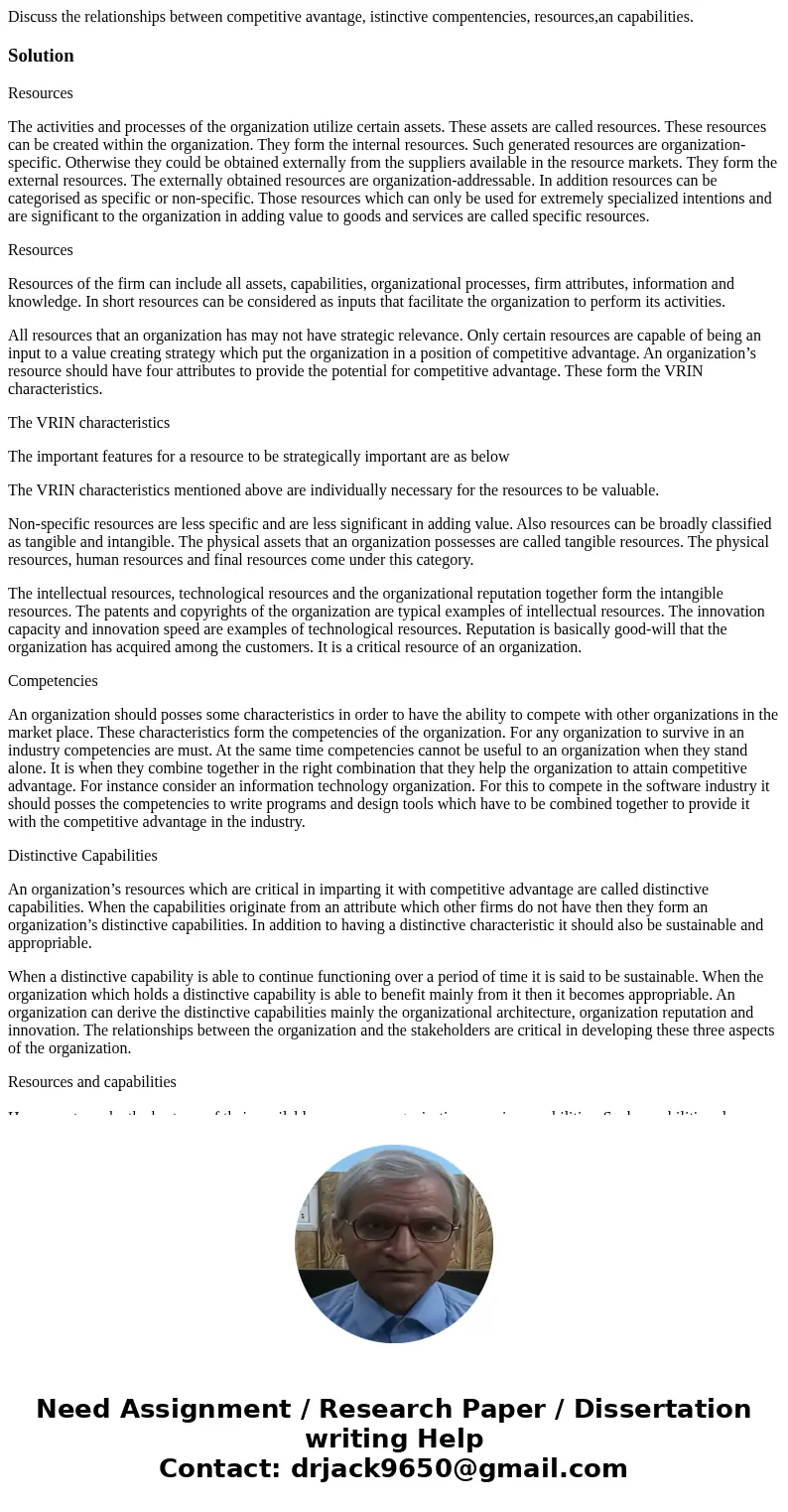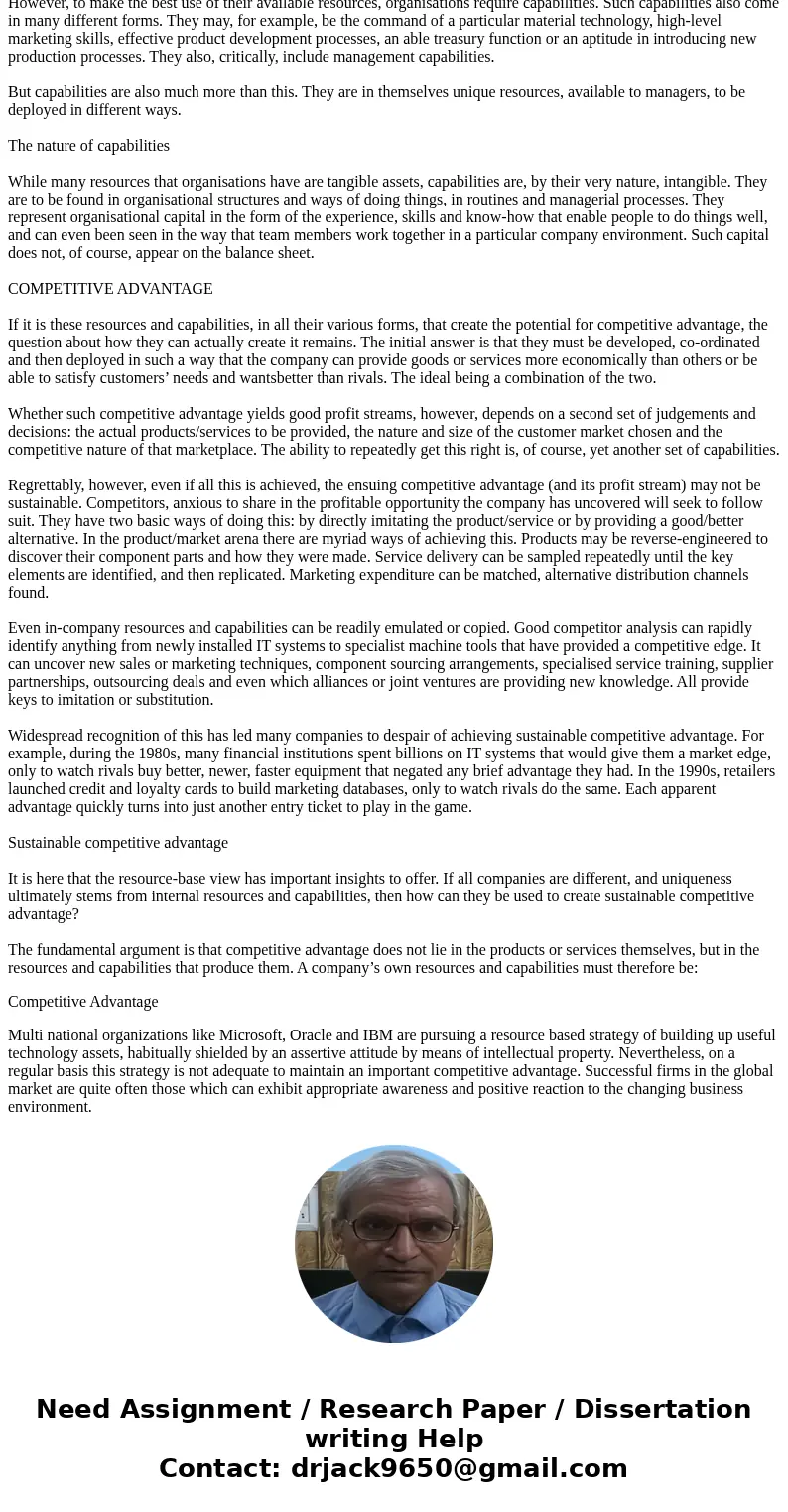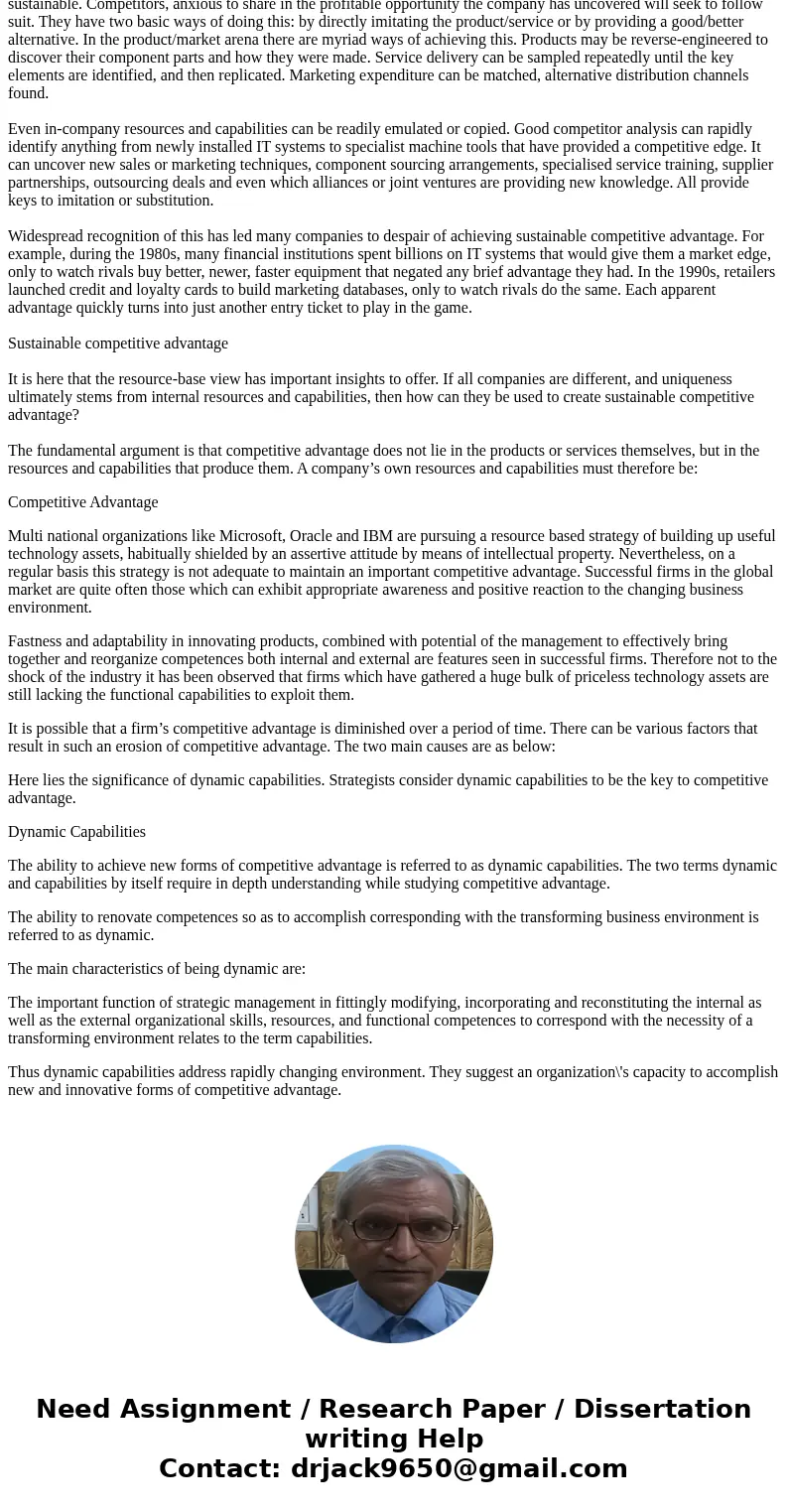Discuss the relationships between competitive avantage istin
Discuss the relationships between competitive avantage, istinctive compentencies, resources,an capabilities.
Solution
Resources
The activities and processes of the organization utilize certain assets. These assets are called resources. These resources can be created within the organization. They form the internal resources. Such generated resources are organization-specific. Otherwise they could be obtained externally from the suppliers available in the resource markets. They form the external resources. The externally obtained resources are organization-addressable. In addition resources can be categorised as specific or non-specific. Those resources which can only be used for extremely specialized intentions and are significant to the organization in adding value to goods and services are called specific resources.
Resources
Resources of the firm can include all assets, capabilities, organizational processes, firm attributes, information and knowledge. In short resources can be considered as inputs that facilitate the organization to perform its activities.
All resources that an organization has may not have strategic relevance. Only certain resources are capable of being an input to a value creating strategy which put the organization in a position of competitive advantage. An organization’s resource should have four attributes to provide the potential for competitive advantage. These form the VRIN characteristics.
The VRIN characteristics
The important features for a resource to be strategically important are as below
The VRIN characteristics mentioned above are individually necessary for the resources to be valuable.
Non-specific resources are less specific and are less significant in adding value. Also resources can be broadly classified as tangible and intangible. The physical assets that an organization possesses are called tangible resources. The physical resources, human resources and final resources come under this category.
The intellectual resources, technological resources and the organizational reputation together form the intangible resources. The patents and copyrights of the organization are typical examples of intellectual resources. The innovation capacity and innovation speed are examples of technological resources. Reputation is basically good-will that the organization has acquired among the customers. It is a critical resource of an organization.
Competencies
An organization should posses some characteristics in order to have the ability to compete with other organizations in the market place. These characteristics form the competencies of the organization. For any organization to survive in an industry competencies are must. At the same time competencies cannot be useful to an organization when they stand alone. It is when they combine together in the right combination that they help the organization to attain competitive advantage. For instance consider an information technology organization. For this to compete in the software industry it should posses the competencies to write programs and design tools which have to be combined together to provide it with the competitive advantage in the industry.
Distinctive Capabilities
An organization’s resources which are critical in imparting it with competitive advantage are called distinctive capabilities. When the capabilities originate from an attribute which other firms do not have then they form an organization’s distinctive capabilities. In addition to having a distinctive characteristic it should also be sustainable and appropriable.
When a distinctive capability is able to continue functioning over a period of time it is said to be sustainable. When the organization which holds a distinctive capability is able to benefit mainly from it then it becomes appropriable. An organization can derive the distinctive capabilities mainly the organizational architecture, organization reputation and innovation. The relationships between the organization and the stakeholders are critical in developing these three aspects of the organization.
Resources and capabilities
However, to make the best use of their available resources, organisations require capabilities. Such capabilities also come in many different forms. They may, for example, be the command of a particular material technology, high-level marketing skills, effective product development processes, an able treasury function or an aptitude in introducing new production processes. They also, critically, include management capabilities.
But capabilities are also much more than this. They are in themselves unique resources, available to managers, to be deployed in different ways.
The nature of capabilities
While many resources that organisations have are tangible assets, capabilities are, by their very nature, intangible. They are to be found in organisational structures and ways of doing things, in routines and managerial processes. They represent organisational capital in the form of the experience, skills and know-how that enable people to do things well, and can even been seen in the way that team members work together in a particular company environment. Such capital does not, of course, appear on the balance sheet.
COMPETITIVE ADVANTAGE
If it is these resources and capabilities, in all their various forms, that create the potential for competitive advantage, the question about how they can actually create it remains. The initial answer is that they must be developed, co-ordinated and then deployed in such a way that the company can provide goods or services more economically than others or be able to satisfy customers’ needs and wantsbetter than rivals. The ideal being a combination of the two.
Whether such competitive advantage yields good profit streams, however, depends on a second set of judgements and decisions: the actual products/services to be provided, the nature and size of the customer market chosen and the competitive nature of that marketplace. The ability to repeatedly get this right is, of course, yet another set of capabilities.
Regrettably, however, even if all this is achieved, the ensuing competitive advantage (and its profit stream) may not be sustainable. Competitors, anxious to share in the profitable opportunity the company has uncovered will seek to follow suit. They have two basic ways of doing this: by directly imitating the product/service or by providing a good/better alternative. In the product/market arena there are myriad ways of achieving this. Products may be reverse-engineered to discover their component parts and how they were made. Service delivery can be sampled repeatedly until the key elements are identified, and then replicated. Marketing expenditure can be matched, alternative distribution channels found.
Even in-company resources and capabilities can be readily emulated or copied. Good competitor analysis can rapidly identify anything from newly installed IT systems to specialist machine tools that have provided a competitive edge. It can uncover new sales or marketing techniques, component sourcing arrangements, specialised service training, supplier partnerships, outsourcing deals and even which alliances or joint ventures are providing new knowledge. All provide keys to imitation or substitution.
Widespread recognition of this has led many companies to despair of achieving sustainable competitive advantage. For example, during the 1980s, many financial institutions spent billions on IT systems that would give them a market edge, only to watch rivals buy better, newer, faster equipment that negated any brief advantage they had. In the 1990s, retailers launched credit and loyalty cards to build marketing databases, only to watch rivals do the same. Each apparent advantage quickly turns into just another entry ticket to play in the game.
Sustainable competitive advantage
It is here that the resource-base view has important insights to offer. If all companies are different, and uniqueness ultimately stems from internal resources and capabilities, then how can they be used to create sustainable competitive advantage?
The fundamental argument is that competitive advantage does not lie in the products or services themselves, but in the resources and capabilities that produce them. A company’s own resources and capabilities must therefore be:
Competitive Advantage
Multi national organizations like Microsoft, Oracle and IBM are pursuing a resource based strategy of building up useful technology assets, habitually shielded by an assertive attitude by means of intellectual property. Nevertheless, on a regular basis this strategy is not adequate to maintain an important competitive advantage. Successful firms in the global market are quite often those which can exhibit appropriate awareness and positive reaction to the changing business environment.
Fastness and adaptability in innovating products, combined with potential of the management to effectively bring together and reorganize competences both internal and external are features seen in successful firms. Therefore not to the shock of the industry it has been observed that firms which have gathered a huge bulk of priceless technology assets are still lacking the functional capabilities to exploit them.
It is possible that a firm’s competitive advantage is diminished over a period of time. There can be various factors that result in such an erosion of competitive advantage. The two main causes are as below:
Here lies the significance of dynamic capabilities. Strategists consider dynamic capabilities to be the key to competitive advantage.
Dynamic Capabilities
The ability to achieve new forms of competitive advantage is referred to as dynamic capabilities. The two terms dynamic and capabilities by itself require in depth understanding while studying competitive advantage.
The ability to renovate competences so as to accomplish corresponding with the transforming business environment is referred to as dynamic.
The main characteristics of being dynamic are:
The important function of strategic management in fittingly modifying, incorporating and reconstituting the internal as well as the external organizational skills, resources, and functional competences to correspond with the necessity of a transforming environment relates to the term capabilities.
Thus dynamic capabilities address rapidly changing environment. They suggest an organization\'s capacity to accomplish new and innovative forms of competitive advantage.



 Homework Sourse
Homework Sourse